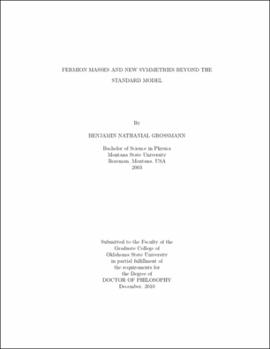| dc.contributor.advisor | Nandi, Satyanarayan | |
| dc.contributor.author | Grossmann, Benjamin Nathan | |
| dc.date.accessioned | 2013-11-26T08:26:33Z | |
| dc.date.available | 2013-11-26T08:26:33Z | |
| dc.date.issued | 2010-12 | |
| dc.identifier.uri | https://hdl.handle.net/11244/6894 | |
| dc.description.abstract | The Standard Model (SM) lacks a satisfactory explanation for the large hierarchy of the fermion masses. The use of extra symmetries is used to create a mechanism to explain this hierarchy. | |
| dc.description.abstract | An additional local U(1) S symmetry is appended to the SM along with an electroweak singlet Higgs boson that has a vacuum expectation value at the electroweak scale. Unlike many other models, the SM fields are neutral under this extra symmetry. Using a Froggatt-Nielsen type mechanism, the mass hierarchy is explained through the interaction of the SM quarks. They do not directly interact with each other, but with additional heavy vector-like quarks that have masses at the TeV scale. | |
| dc.description.abstract | How the Higgs singlet contributes to the generation of the mass hierarchy is generalized across a set of 24 model variation. Some of the phenomenology of Higgs interactions with SM fields by Higgs decays and flavor changing neutral currents are also explored. | |
| dc.description.abstract | The direct interaction of a heavy vector-like quark with a SM quark (the bottom quark) is also examined. The signal rates of this heavy vector-like quark and the SM background are calculated for the dominant signals at the high-energy hadron colliders, multilepton and multi-b-jet final states. For a wide range of masses, the signals are above the background at the LHC. | |
| dc.description.abstract | The neutrino masses are addressed by a different symmetry. Imposing a Z 2 symmetry, the SM neutrinos have interactions with two new Higgs fields and heavy right-handed neutrinos with masses in electroweak scale. The smallness of the left-handed neutrino masses is the result of a combination of fine tuning between the two new Yukawa couplings and using the see-saw mechanism. The proposed scenario gives interesting new Higgs decay signals and can be tested at the LHC. | |
| dc.format | application/pdf | |
| dc.language | en_US | |
| dc.rights | Copyright is held by the author who has granted the Oklahoma State University Library the non-exclusive right to share this material in its institutional repository. Contact Digital Library Services at lib-dls@okstate.edu or 405-744-9161 for the permission policy on the use, reproduction or distribution of this material. | |
| dc.title | Fermion masses and new symmetries beyond the standard model | |
| dc.contributor.committeeMember | Babu, Kaladi S. | |
| dc.contributor.committeeMember | Binegar, Birne T. | |
| dc.contributor.committeeMember | Perk, J. H. H. | |
| osu.filename | Grossmann_okstate_0664D_11264.pdf | |
| osu.accesstype | Open Access | |
| dc.type.genre | Dissertation | |
| dc.type.material | Text | |
| dc.subject.keywords | collider phenomenology | |
| dc.subject.keywords | fine-tuning | |
| dc.subject.keywords | froggatt-nielsen | |
| dc.subject.keywords | mass hierarchy | |
| dc.subject.keywords | tev scale physics | |
| dc.subject.keywords | vector-like quarks | |
| thesis.degree.discipline | Physics | |
| thesis.degree.grantor | Oklahoma State University | |
